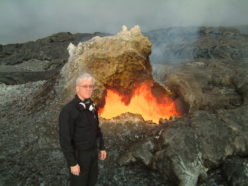As teachers we always want to encourage questions – not discourage questions. Sometimes, however, people will start with a question and then on their own figure out an “answer.” If the answer isn’t grounded in reality – some basic education being necessary here – then the answer can get out of control and move beyond reality very quickly. The following is an example of this.
Q: Could my strategy for fixing yellowstone work?
Build a huge reservoir container made of titanium, nickel,and cobalt. Then build a 4d scanning system that monitor the lava pressure within yellowstone as it increase. Build a drain made out of titanium,cobalt,nickel, using gravity slowly drain lava into reservoir as the lava pressure increases to maintain lava at the below level of erupting sustain it at that level as plates shift friction ignites gases in lava then lava increases so I do not think that cooling it will work sufficiently in my opinion. by keeping lava in core low in volcanoes maybe we can reduce friction of constant shifting plates. PLEASE write back.
–misty c
A: You are operating under a rather large number of mistaken assumptions.
First of all, friction does not ignite volcanic gases; they tend to be primarily SO2 and CO2, and both of them are already oxidized. In other words, they can’t “ignite.”
Second, you cannot monitor lava pressure in “4D” or even 3D remotely – you can only guesstimate it from laboratory pressure-cell studies coupled with depth/thickness estimates from seismic reflection experiments.
Third, there is not enough money in the entire US GDP to pay for a container of titanium, nickle, and cobalt of any size that might be even remotely comparable to the output of even a small Yellowstone eruption.
Fourth, while such a container as you describe would probably not melt at typical magma temperatures (~1,300 C), it would be structurally weaker than at ambient temperatures. It would be a very complex engineering problem. Actually, why would you even need a container at all? The Earth’s surface is covered with vast sheets of cooled lava in many places, including Siberia, western India, and the Pacific Northwest.
Fifth, the Yellowstone caldera is nearly 45 miles (72 kilometers) across. There are several rough estimates from seismic data of how large the magma reservoir beneath it is, and they are all huge – and highly dependent upon how far down you want to count. Down to the top of the Mantle? Some recent research suggests that the Yellowstone hot spot plume rises from a depth of at least 440 miles (700 kilometers) deep within the Earth’s Mantle. Some researchers suspect it originates from 1,800 miles (2,900 kilometers) deep at the top of the Earth’s core. In other words, that is a LOT of magma. The last really large eruption 640,000 years ago blew out the equivalent of 1,000 cubic kilometers of DRE (dense rock equivalent). In other words, 240 cubic miles of rock blasted to tephra and ash that reached as far as the East Coast of the US.
Sixth, to “drain” something you would need pressure or gravity to work for you; no known pump could handle molten magma. Moreover, the current understanding is that the magma under Yellowstone is a highly-viscous, mostly-crystal mush (only a 2% – 9% melt fraction remains from seismic tomography data interpretation). An “eruptible” magma would require at least a 50% – 60% melt fraction. The top of the magma now lies at least 4 miles (6 kilometers) below the Earth’s surface. It is already being contained by an overlying cap of volcanic rock left from previous eruptions that have now cooled. Experimental drilling to those sorts of depths is extraordinarily difficult. The Kola Peninsula Superdeep Borehole in Russia took two decades to reach six miles (10 kilometers) depth. It’s terminal aperture was just 9 inches/23 cm in diameter. Rock turns plastic before you get to those depths, closing in and trapping the drill-stem.
Just compare that 23 centimeter-diameter borehole to the width of the caldera at 72,405,000 centimeters. There is no way you could “drain” Yellowstone through a drill hole that small (even if the magma was hot, pressurized, and non-crystalline) in the all the time that the Earth has existed.
Finally, until you are actually physically standing on a volcano, you cannot really understand how immense it is. Volcanoes dwarf the creations of humankind. The forces involved in even a small to moderate eruption are far greater than anything mankind can develop with modern technology, including fusion bombs – and Yellowstone is a Supervolcano. All you can do is get out of the way when ANY volcano decides to do its thing.
I have not even begun to address the formidable engineering difficulties of your plan.
This may not be the kind of response you may have expected; I’m trying to give you a scale-based reality-check here. You can learn a lot more by reading some of the scientific literature, readily available on the internet, for instance:
http://science.sciencemag.org/content/348/6236/773?ijkey=c0dac9ef6421b172d426307cf7fa08be7986dee6&keytype2=tf_ipsecsha

first comment, yeeey!
first comment, yeeey!
I like this website so much, saved to favorites. “Nostalgia isn’t what it used to be.” by Peter De Vries.